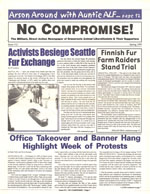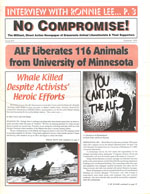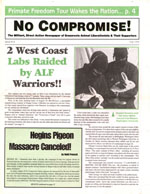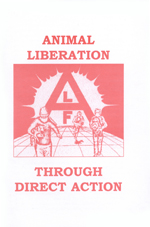The Archives
-
One-off publications
Animal Liberation Through Direct Action
03.28.14 | PermalinkAnimal Liberation Through Direct Action – (Date of publication unknown, likely 1998. Country of origin unknown, likely England)
Animal Liberation Through Direct Action was one of the better primers available in the 1990s. Designed for activists who had never before participated in illegal actions, the pamphlet discusses the basic security, surveillance, and planning necessary to carry out liberations and economic sabotage. It also includes a brief history of the movement, a first hand account of a mink farm raid, and statements from various ALF cells.
…
-
No Compromise, Periodicals
No Compromise #12-14
05.15.12 | PermalinkNo Compromise #12-14 (1999, Old Bridge, NJ and Santa Cruz, CA)
If I had to create a list of my favorite years in animal and earth liberation history, 1999 would be in the top 5. As the movement looked towards the new millennium there seemed to be an intense urgency in the air, perhaps people felt the need to close the 20th century with a bang or leave their mark before the world ended in a technological melt down on Y2K! Whatever the reasons, direct action reached a fever pitch. Lab raids returned to the United States, the Earth Liberation Front continued it’s ascendancy, Hillgrove farm was shut forever, and everyone seemed to be preparing for the World Trade Organization ministerial in Seattle. Across the globe there was a sense that people were not going to take it anymore, and whether you were struggling against bio-technology or prisons or speciesism, chances are good that you were employing some form of illegal tactic.
No Compromise may not have covered everything going on in the global struggle, but if it was animal lib related then chances are it was covered in these three issues. From the death of Alex Slack to end of the annual Hegins pigeon massacre, you’d be hard pressed to find a more complete overview of these twelve action packed months.



-
Most Popular, One-off publications
Got the Hollowpoints for the Snitches
03.13.12 | PermalinkGot the Hollowpoints for the Snitches (2005, United States)
The greatest weapon in the government’s repressive arsenal is the snitch. These sorry examples of humanity provide big brother with an insider’s view of communities of resistance, spread fear and distrust in revolutionary circles, and gift law enforcement with profiling tools to find likely dissenters in the future. Dealing with this problem is one of the most difficult challenges of a militant movement.
While the title of this zine (Taken from Dr. Dre’s Let Me Ride) may seem like unnecessary posturing, the contents contain an intelligent examination of the historical role of snitches, how other movements have dealt with them, and a rogues gallery complete with contact information for dozens of traitors. Written during the early days of the Green Scare, it offers a look into the mindset of frontline activists during a time when snitching was epidemic.
(NOTE: If you have arrived at this page from one of Corey Wrenn’s blogs please be aware that this document was not produced by or for the Animal Liberation Front as she often claims. Furthermore, be aware that, for better or worse, no one listed inside has been subjected to violence as a result of their listing.)
…
-
Periodicals, Underground
Underground #14-15
06.21.11 | PermalinkUnderground 14-15 (1999, Ontario, Canada)
The turn of the century was an odd time in the world of radical politics. The remnants of the mid-90s militants grassroots were fading away, and those still loyal began to look to England for signs of hope. In Eugene, an odd coalition of old school forest activists, crusties, anarchists, and even some members of the old left were rapidly embracing a philosophy critical of civilization, leftism, and pacifism. People all over the globe were beginning to talk about the specter of global trade agreements, and everyone began planning for the World Trade Organization meetings in the northwest, where arsons, lab raids, and whale hunt sabotages were already rampant. Everywhere there was a sense that the old politics were dying, and that something new was right around the corner.
Underground reflected some of this feeling, but production delays, staff turnover, and the rapid loss of its old writers meant that only 2 short issues were produced this year. Some great history was documented in these pages, but sadly much was left uncovered. These two issues should be thought of as an incomplete sampling of just some of what ’99 brought the world.
Also see Underground 1-3 and Underground 4-6 and Underground 7-9 and Underground 10-13 and the final rare issue, Underground 16.


…






